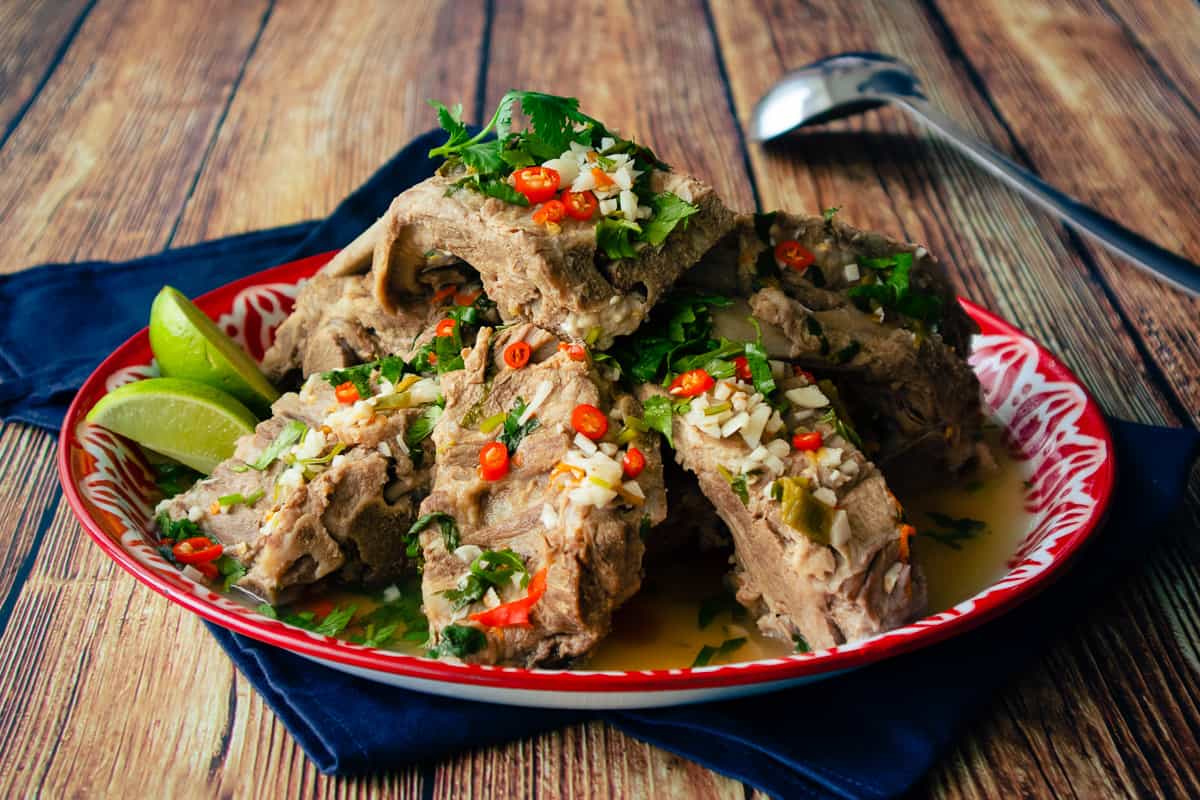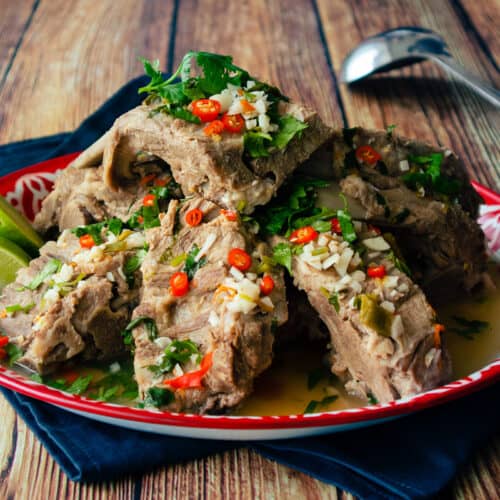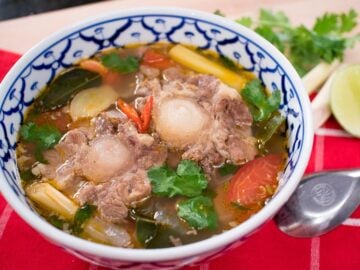A few years ago, Mark Wiens posted a video titled "The Most INSANE Street Food in Thailand". Where he was eating a mountain of tender-braised pork bones "soup," with the bones piled higher than his head, surrounded by a delicious spicy broth laced with chilies and cilantro.
That video has now been viewed over 7 million times, and of course I've received MANY requests for the recipe! The good news is that it's actually easy to make at home and IS as tasty as Mark says it is. You'll also end up with extra broth that's perfect for more street foods such as spicy Tom Yum Noodles!

Want to save this recipe?
A dish made from just...bones?
If you think it's crazy that we should be eating a dish made from bones, hear me out. This dish is made from pork neck/back bones, which are most commonly used for making Thai noodle soup broths. But they have a lot of meat on them tucked away in all the nooks and crannies as well.
In fact, every time I make pork stock with these, once it's done simmering I remove all of the tender meat that is practically falling off the bones, and I always end up with enough meat for a full meal for two adults!
So you can think of this like eating ribs. There are a lot of bones, but also a lot of meat. If you eat chicken feet, this has way more meat than that. I'm pretty sure this dish was created because some noodle soup vendor thought there's enough meat in these bones to be a whole nother dish!
What does "leng saeb" mean?
Leng is short for ia leng which means pork spine in Teochew Chinese. They're the bones most commonly used to make pork stock for noodle soups because they have a lot of cut surfaces exposing the interior of the bones, cartilage and marrow which give the broth rich flavour and body.
Noodle soups were originally introduced to Thailand by Teochew immigrants, which is why Thai people have adopted the Teochew term. (Many Thai people are of Teochew descent, myself partially included.) Fun fact: Leng actually means dragon, and when the spine bone is removed from the pig, it is long like a dragon!
Saeb on the other hand, means delicious in Lao. But when Thai people use it, it's used to mean "spicy and delicious." This is because Lao food is generally more spicy than Thai food.
So "Leng Saeb" means spicy, tasty pork bones!
Bones Buying Guide
You can find leng bones at most Chinese butchers or grocery stores sold as either pork neck bones or pork back bones. In my experience pork neck bones are meatier, so that's what I use. But if you can only find back bones that works as well. They will not be cut into the foot-long pieces you see in Mark's video above, but that's actually good because it makes them a lot more manageable!

As you might suspect, you can absolutely make this dish using pork ribs. Baby back ribs or spareribs will work just as well, and you can separate the bones into smaller chunks so they will fit into your stock pot. It will actually be a little easier to eat, but the resulting stock might not be as rich because ribs have fewer exposed bone surfaces, which are what gives body and flavour to the stock.
Alternatively, you can use chopped spare ribs that are often sold in small pieces at Chinese butchers - and as I used in this dim sum spare ribs recipe. This will be a better option than full pork ribs because there are many more exposed bones and a lot more cartilage (also great for a full-bodied stock) and it'll be much easier to eat. You'll be missing is the impressive "mountain" experience, but it'll taste just as good.
Ingredients You'll Need
There are 2 steps to making leng saeb; the first is braising the pork bones and making the base stock, and the second is turning that stock into the saeb broth.


Step-By-Step:
Here's the bird's eye view of the process, but be sure to check out the full video tutorial in the recipe card below to ensure success!


Pro Tip: Making Eating Easy
Since you'll be eating meat off the bones, be sure to cook it long enough that the thickest part of the meat is super fork tender and comes off the bones easily. Your total cooking time should be at least 2 hours, and may even be 2.5 hours for particularly meaty bones.
Frequently Asked Questions
Absolutely! You can make this recipe with chicken feet if you like them, or wings. For beef you can use oxtail. Chicken will take 30-45 minutes to become tender, oxtail can take up to 3.5 hours. Or try this Thai oxtail soup recipe that has a similar vibe.
You can make this dish using pork ribs. Baby back ribs or spareribs will work just as well. You can separate the bones into smaller chunks so they will fit in the pot. It will actually be a little easier to eat, but the resulting stock might not be as tasty because ribs have fewer exposed bone surfaces, which is what gives body to the stock.
Alternatively, you can use chopped spare ribs that are often sold in small pieces at Chinese butchers, like the ones used for this dim sum spare ribs recipe. This will yield a better stock because there are many more exposed bones and a lot of cartilage. It'll also be much easier to eat, but the presentation will not be as extravagant as you won't have the mountain!
Yes, but since chilies add a nice flavour to the broth, I suggest removing the seeds and pith from the chilies rather than using fewer chilies.
Like this recipe? You'd also love these!
Here are two recipes that have a similar meat-on-bone-in-spicy broth vibe. The fish has practically the same broth as this recipe, but the oxtail has more of a tom yum feel with lemongrass, galangal and lime leaves.
Before you start, be sure to watch the video tutorial to ensure success! I always include little tips and tricks not mentioned in the blog post. The video is in the recipe card below, but you can also watch it on YouTube.

Thai Spicy Pork Bones Soup - "Leng Saeb"
Want to save this recipe?
Ingredients
For the pork stock:
- 3 lb pork neck or back bones, see note 1
- 3.7 qt water
- Half an onion, large dice, see note 2
- Half a head garlic, peeled and smashed
- ½ teaspoon white peppercorns, cracked
- 2 tablespoon soy sauce
- 2 tablespoon fish sauce
For the Leng Saeb Broth
- 2 cups pork stock, from above
- 3 tablespoon lime juice
- 1 tablespoon fish sauce, approx
- 2 teaspoon sugar
- 3 tablespoon chopped garlic
- 3-4 Thai chilies, seeds removed if needed
- ⅔ cup chopped cilantro, if you have sawtooth coriander, you can add it too
- Jasmine rice for serving
Notes
- You can buy pork neck bones or back bones at Chinese butchers or grocery stores. Choose neck bones if you can, as they tend to have more meat. Alternatively, you can use pork ribs. See more info in the FAQ above.
- If you have daikon radish, you can add about 2 cups of peeled and large diced daikon to the broth either instead of, or in addition to, the onion.
FULL VIDEO TUTORIAL
All my recipes come with step-by-step video tutorials with extra tips not mentioned in the blog post, so make sure you watch the video to ensure success. If you enjoy them, consider subscribing to the YouTube Channel to not miss an episode. Thank you!
Subscribe to my YouTube ChannelInstructions
To make the pork stock
- In a large stock pot add the bones and cover with the water. Add the soy sauce and the fish sauce and bring to a simmer. Simmer for 30 minutes or until a significant amount of scum collects on top. Skim off the scum and discard.3 lb pork neck or back bones, 2 tablespoon soy sauce, 2 tablespoon fish sauce, 3.7 qt water
- Add the onions, garlic, and peppercorns and simmer for another 1.5 hours or until the meat is fork tender. If water dries up too quickly, top it off just until the bones are submerged.Half an onion, Half a head garlic, ½ teaspoon white peppercorns
To make the Saeb broth
- Take 2 cups of the pork stock and bring to a boil in a small pot. Keep the pork bones in the broth to keep them moist until ready to serve. Meanwhile pound the chilies in a mortar and pestle until broken into bits or finely chop them.2 cups pork stock, 3-4 Thai chilies
- Once the broth is boiling, turn off the heat and immediately add the garlic and chilies. Season with the sugar, fish sauce and lime juice, then taste and add more fish sauce if needed. (How much fish sauce depends on how far your stock reduced, so you have to taste and adjust here.) When ready to serve, stir in the cilantro.3 tablespoon lime juice, 1 tablespoon fish sauce, 2 teaspoon sugar, 3 tablespoon chopped garlic, ⅔ cup chopped cilantro
To serve
- Arrange the pork bones into a big pile on a platter that has enough depth to it to hold the broth. Ladle the seasoned broth over the pork, allowing the garlic and the chilies to rest on the bones. Serve with jasmine rice. You can use a spoon and fork to pick the meat off of the bones, but feel free to use your hands when needed. The broth is the best part of this, so be sure to sip on that as you eat, and drench your rice with it!*You can save the remaining broth for noodle soups. They will last in the fridge for about a week, and will freeze indefinitely.Jasmine rice for serving









John Savage says
Wow Pailin, this is a winner, I did change it up a bit and put the bones in my Instant Pot pressure cooker for 40 minutes (quick release). I also added 2 star anise for that bit umami and one tablespoon of fresh ginger. For a bit of smokiness 3 tsp smoked paprika. What a rich flavourful bone broth and the meat was delectable, so healthy. I will be adding Asian greens to the finished broth.
* Especially great for those on low carb diets!
Tom says
Seems weird to not use galangal or lemon grass in this recipe
T says
I thought so too but I added 1 stick of Lemongrass and it still taste great
LW says
I just made this -- great recipe, totally reminded me of the street food dish we had in Bangkok a few years back. Thank you for making this recipe available so I can recreate it at home and bring back some good memories.
Diana Evans says
Aroy mak ka!!!!
So incredibly good, with the typical wonderful balance of flavors that is Thai cooking. Spicy, sour, sweet, and salty. Loved it.
Khup khun ka
Kelly says
Wow wow wow!! Made this tonight and it was a huge hit for my family! Need to make more next time cuz we demolished it in record time! Thanks for the fantastic recipe! This will surely be on rotation from now on❤️
Beck & Bulow says
love this recipe! I always have a batch frozen.